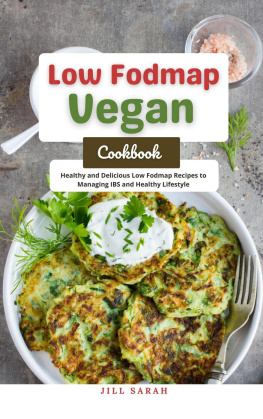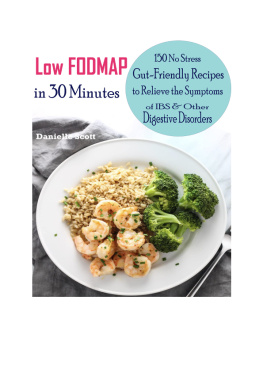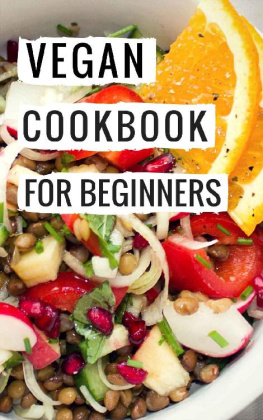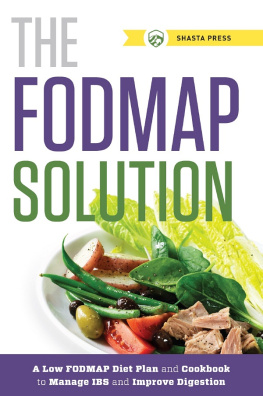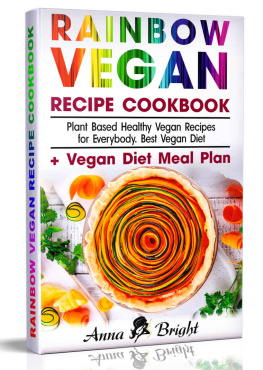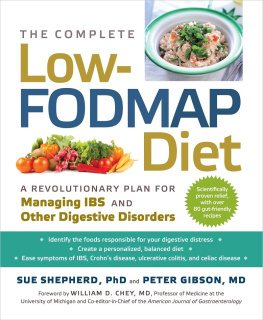Low-FODMAP Vegan Cookbook
Low-FODMAP
Vegan
Cookbook
30 Day Meal Plan and 100 Healthy and Delicious Low-FODMAP Vegan Recipes to Make You Feel Great
Amica Alba
LEGAL NOTICE Copyright (c) 2019 by Amica Alba All rights are reserved. No portion of this book may be reproduced or duplicated using any form whether mechanical, electronic, or otherwise. No portion of this book may be transmitted, stored in a retrieval database, or otherwise made available in any manner whether public or private unless specific permission is granted by the publisher. Vector illustration credit: vecteezy.com This book does not offer advice, but merely provides information. The author offers no advice whether medical, financial, legal, or otherwise, nor does the author encourage any person to pursue any specific course of action discussed in this book. This book is not a substitute for professional advice. The reader accepts complete and sole responsibility for the manner in which this book and its contents are used. The publisher and the author will not be held liable for any damages caused. |
CONTENTS
INDEX
Living My Best Low FODMAP Vegan Life
My whole life, Ive suffered with a sensitive stomach. When I was a kid, my parents always thought it was because I was eating too much or making myself sick to get out of responsibilities. As I got older, I figured out that certain foods tended to give me symptoms like cramping, bloating, and diarrhea, so things got a little better when I avoided those foods. However, I was still known in my friend group as the sickly one. It was embarrassing, but I tried to laugh it off. It was just how life was, and I didnt think anything would change.
Things did get a little better when I decided to become a vegan. I always believed that I was sensitive to dairy, so I stopped eating it, along with meat. That may seem like an extreme step, but I was never a big meat-eater anyway, mostly because I grew up with a vegetarian mom. Being vegan has become a lot easier in recent years, too. I didnt get as sick quite as frequently on my vegan diet, so I thought I had finally solved the problem as much as it could be solved. I was okay with how I lived my life.
After college, however, things got as bad as they had ever been, health-wise. I went through some big life changes, and the stress took a toll on my body. It seemed like my list of food sensitivities increased tenfold, and I was afraid to eat anything new. Even the food I made for myself wasnt necessarily safe, but at least when I was at home, I didnt have to deal with the embarrassment of getting sick in public. I started avoiding going out with friends or to work functions, and I felt lonely and disconnected from my own life. Something had to change, so I went to my doctor.
She listened to my symptoms and then recommended I see a gastroenterologist. After some tests, including an ultrasound, I was officially diagnosed with IBS. I felt a weird mix of emotions, including relief and dread. At least it wasnt all in my head, but IBS is a chronic disorder. It wasnt something that would just go away. I spent a few days after my diagnosis moping around, feeling sorry for myself. Then I got tired of wallowing in self-pity and decided to tackle this thing head on.
Theres a wide range of treatment for IBS, including medications and supplements. My health team recommended a change in diet. We talked about the Low FODMAP, which I had never heard of, but it intrigued me. I started doing more research and learned that its a diet for a variety of GI disorders, including IBS, Crohns, and celiac disease. FODMAPs are a type of carb, and in high amounts, they are hard for the body to break down. They end up in the large intestine, fermenting with the bacteria there, and aggravating the symptoms I was experiencing with IBS. FODMAPs dont IBS or other GI disorders, but they can make it worse.
I decided to try the diet. It wasnt a decision I made lightly. The first phase of the Low FODMAP diet was very challenging, since I had to eliminate a long list of high FODMAP foods. These foods include staples I used heavily in my vegan diet, including wheat, mushrooms, onions, garlic, apples, and beans. Seeing how much I had to eliminate was really intimidating, at first. My family and friends were concerned. Veganism is already such a restrictive diet, they said, and now I was going to restrict it even more? Was this really what I wanted to do?
I cant overemphasize how important my health team was at this time. They helped me build an eating plan that was nutritious, tasty, and followed both vegan and Low FODMAP diet rules. This book contains the recipes I depended on during the hardest part of the diet. Thanks to these recipes, resources from Monash University (where the diet was created), and my team, I was able to get through the Elimination Phase of the diet.
The second phase, known as the Reintroduction phase, was trickier in a different way. During this phase, you add high FODMAPs back into your diet very gradually, one at a time, to see how the body responds. I learned that certain high FODMAP foods didnt affect my symptoms at all, specifically beans, which Im very grateful for, while my body did not like garlic and onion. Armed with this essential information, I was able to create a list of food I knew to avoid and significantly build my regular diet back up to include a lot of nutritious foods. That meant no more guesswork, hoping for the best, or living in fear of food.
For me, thats the biggest takeaway from the Low FODMAP diet: no more fear. I finally feel in control of my IBS and Ive been practically symptom-free now for two years. Im not identified as the sickly one anymore, and I actually enjoy cooking and eating. It isnt like living in a minefield. Everyone with a GI disorder should have this freedom. I hope this book provides you a roadmap for better health and gives you lots of ideas for vegan cooking. Being symptom-free is within reach and life is so much richer when food isnt a source of fear.
Yours in love and wellness,
Amica Alba
Introduction To The Low FODMAP Diet For Vegans
The Low FODMAP diet is an eating protocol designed for people suffering from GI disorders, like IBS. In this introduction, well explore what FODMAPs are, what the Low FODMAP diet is, and how to succeed through the trickiest parts of the diet. If youve been suffering from a GI disorder and are looking for a way to treat it through diet, the Low FODMAP diet could work for you.
What are FODMAPs?
Before we get into why a Low FODMAP diet is healthy, lets talk about what FODMAPs actually are. FODMAP stands for fermentable oligosaccharides, disaccharides, monosaccharides, and polyols. These are short-chain, simple carbs. Depending on the food, there will be different amounts of them. The foods with high amounts of FODMAPs are harder for the body to process. The small intestine in particular has trouble. This is bad news because the SIs job is to absorb nutrients. If your diet is too high in FODMAPs, the SI may not be able to break them down and absorb their nutrients, so they move to the large intestine. The large intestine isnt as good at absorbing, so instead, the FODMAPs start reacting with the LIs bacteria. This causes fermentation, which leads to health problems like gas and excessive water in your intestinal tract. If you have a digestive disorder like IBS or SIBO, high-FODMAP foods make your condition worse.


